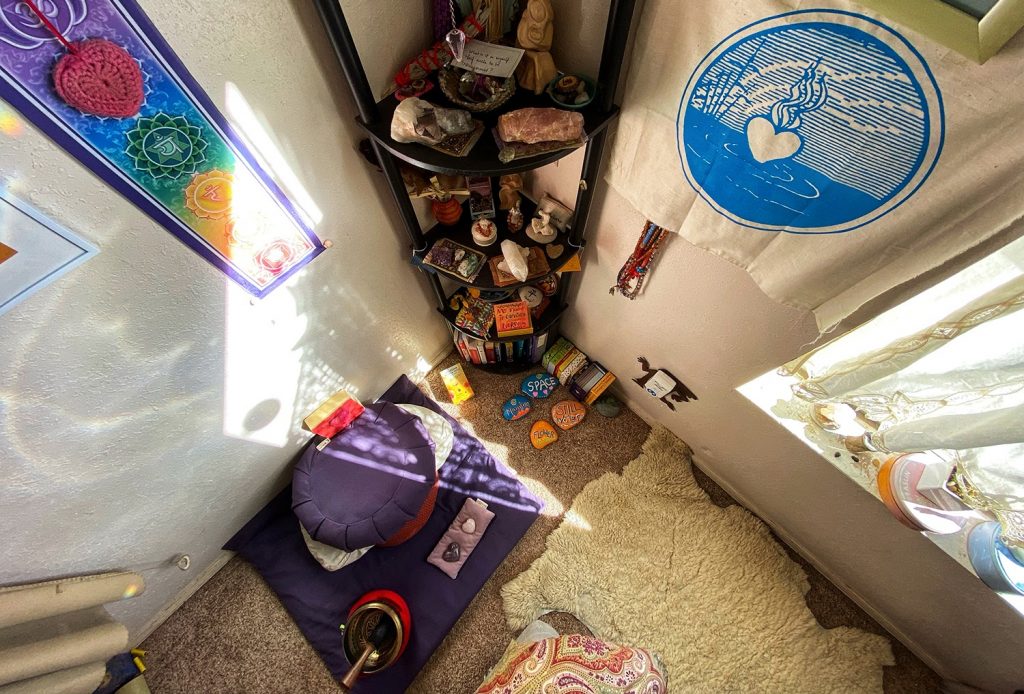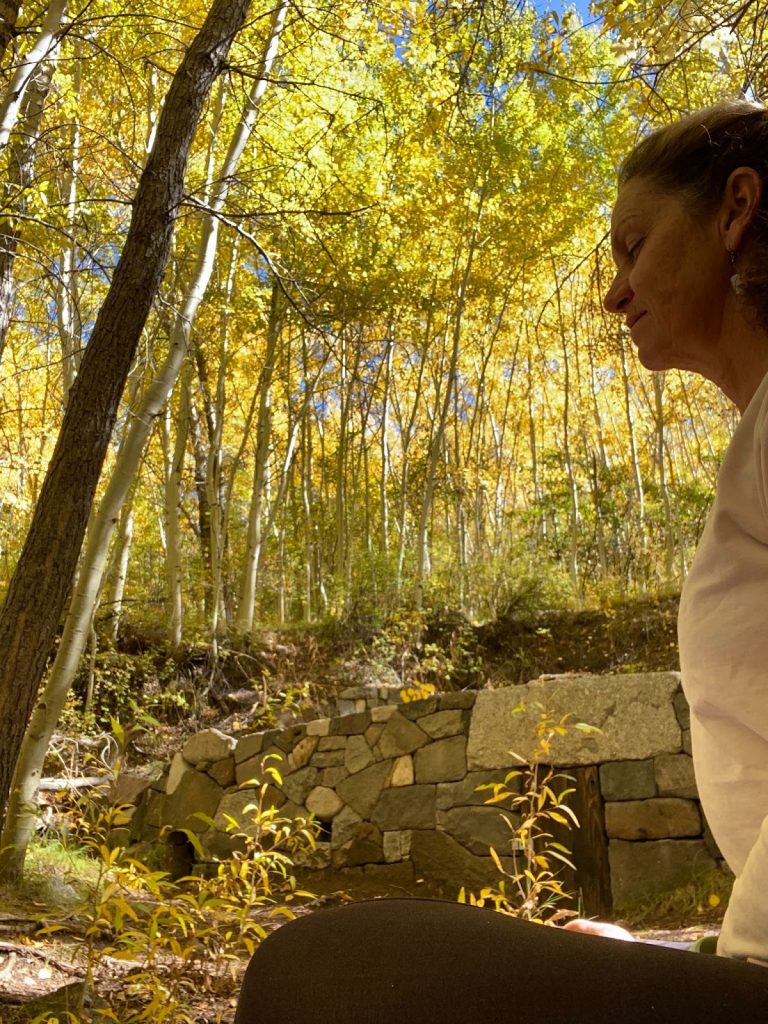By Anne-Marie Emanuelli, Founder and Creative Director at Mindful Frontiers LLC
Introducing mindfulness meditation into our life is a worthy endeavor. Contrary to popular myth, meditation is not about trying to stop thoughts. Quite the contrary, the mind is thinking all the time; stopping that is just not realistic. Rather, meditation is allowing thoughts, noticing them, and then providing the mind something else to think about in the present moment.
But first, we must set ourselves up for success by making space, time, and opportunity for meditation to come into our life. Anne-Marie Emanuelli, founder of Mindful Frontiers explains how in 5 easy steps:
- Find a comfortable space in which to sit and be still. Whether it is a corner of a room where there are cushions, a designated chair, or a separate meditation room, the first step is to dedicate a place at home for meditation. Should you live in a region where the weather is consistently agreeable for outdoor sitting, your meditation space could also be outdoors in a courtyard, patio, or under a welcoming tree.
- Start by trying out different times of the day to meditate until you find the one that is accessible on a regular basis. Some meditators prefer the morning while others enjoy finishing the day with their meditation practice. It doesn’t matter, really, as long as it becomes a routine. It is much more beneficial to have a short daily practice than a long weekly one. However, at the start, this is a bit of trial and error. And, above all, no judgment. Just practice, practice, practice until the right moment is found.

- The beginner will find that guided meditation is easier to fit into the day. Whether guidance comes from a mobile app, an online group, or an in-person class, the key is to practice regularly and figure out what works best.
- Once a regular practice time and the setting is established, the key is to commit to this for a while. Certainly, we can change it up from time to time and in the beginning, consistency is really important. Anne-Marie suggests sticking to something for several months or an entire season before changing the framework. For example, in-person classes may be more accessible during warmer months whereas online practice may fit better during the colder months. Also, the online practice may fit best into your day because you just need to wake up, turn on the computer and sit. Mindful Frontiers offers a variety of ways to bring meditation guidance into your life.
- Lastly, after several months of consistent practice, expand knowledge by reading as much as you can to build wisdom. There are many excellent books, magazines, blogs, and videos to add depth and understanding to your practice. Journaling is also a great way to channel thoughts and inspiration.
What is mindfulness?
Mindfulness according to Jon Kabat Zinn, MBSR founder and author of Full Catastrophe Living is “the awareness that arises from paying attention, on purpose, in the present moment and non-judgmentally.”.
Eastern contemplative traditions have a long history of practicing meditation. Today, mindfulness is practiced by people all around the world, with many diverse languages, cultures, and spiritual beliefs.
Meditation is a simple practice that is worth the effort. The practice entails keeping our attention on the present moment using an awareness anchor: the breath, sound, sensations, sight, etc. Since the mind likes to wander, the purpose of mindfulness is to keep our attention on the present moment and to distract the mind with these anchors.

People turn to meditation because of a need for physical, emotional, spiritual, healing. Once a person starts meditating, they realize that the benefits go beyond a healing practice. It quickly becomes a lifestyle choice. Having an unrealistic goal of stopping all thoughts or finding enlightenment is a myth and not recommended, at least for the beginner. Meditation is not about what you get; rather, it is about what you let go of.
Mindfulness meditation has both formal and informal practices. Formally, we take time from our busy schedule to sit, lie down or walk with intention and focus. Informal practice is when we take one or more deep breaths before moving on to another activity or as a brain break. Informal mindfulness breaks are just as important as formal sitting practices.
Although meditation sounds simple, it is not easy. The work of turning towards ourselves requires vulnerability and courage as we train our minds to give up control. We turn attention inward, nurturing our awareness with kindness and self-compassion. These practices gently bring heartfulness to the forefront of our daily activities.
Present-moment awareness is a practice of recognizing actual reality. Oftentimes what causes stress is getting caught in non-reality. We ruminate about the past, fret about the future, and forget to acknowledge that in this present moment, all is well and as it should be. We fabricate interpretations and stories that are created in the mind. These thoughts are not reality at all but a made-up “irreality” or story. The only reality is right now in this present moment experience.

The benefits of practicing mindfulness are numerous and practical. Keep in mind, however, that meditation is not practiced to “get somewhere”, “do something” or “be someone”. The ultimate reason to meditate is to surrender to the present moment without expectation or goal.
- Lowering stress
- Increasing compassion
- Lowering reactivity
- Improves sleep
- Managing pain
- Decreasing anxiety
- Keeps our brain healthy
There are many types of meditation practices that have meaning and relevance for a wholehearted life. The following are a few practices that can be done individually or in combination.
- Mindfulness meditation
- Insight meditation
- Movement meditation includes yoga, walking, or dancing
- Mantra/affirmation-based meditation with songs, statements, or lyrical inspiration
- Yoga Nidra or whole-body relaxation
- Body-scan meditation
- Progressive muscle relaxation
- Loving-kindness meditation
- Visualization meditation
The type of meditation that Mindful Frontiers specializes in is Insight-style mindfulness that channels heart-based compassion, loving-kindness, and visualization inward and outward. This combination comes from years of practice and exploration and is what has brought healing and harmony to Anne-Marie’s life. She teaches that which she has benefitted from. Mindful Frontiers’ Linktree page has links to classes and offerings.
Not all meditation styles are right for everyone. These practices require different skills and understanding. Figuring out which style is right for you takes practice and exploration. They all have a couple of things in common, and attention anchor and consistency.
Attention Anchor
Mindfulness uses something that encourages the mind to stay connected to the present moment. Most often the breath is our anchor. We can also use sound, body sensations, or other sense awareness. When practicing mindfulness we know that we can’t stop thoughts from coming into our awareness and we do not judge ourselves when this happens. We gently bring our awareness back to the anchor. Whether you choose to focus awareness on the breath, body, sensations, emotions, sounds, or other anchors, you are giving yourself permission to have freedom of choice at the moment. You are taking care of yourself, one breath at a time.
Consistency
Since mindful meditation is a practice, it takes consistency and commitment. Even though meditation isn’t a chore, it does require commitment so scheduling it into the day is the best way to bring consistency. Using apps, timers, alarms, calendar reminders all help to bring meditation into the routine. Once the routine is established, the benefits will be felt. Some practitioners prefer mornings while others enjoy evening meditation. Explore different times of day until one fits and becomes a welcome part of your life.
Good luck with your blossoming meditation practice. Be kind to yourself and stay curious about what is going on. That’s mindfulness at its core.
Mindful Frontiers LLC
P.O. Box 828 / El Prado, NM 87529 / (575) 770-3683 / [email protected]
MindfulFrontiers.net / Linktr.ee/Mindful.Frontiers / Mindful Frontiers Youtube Channel






